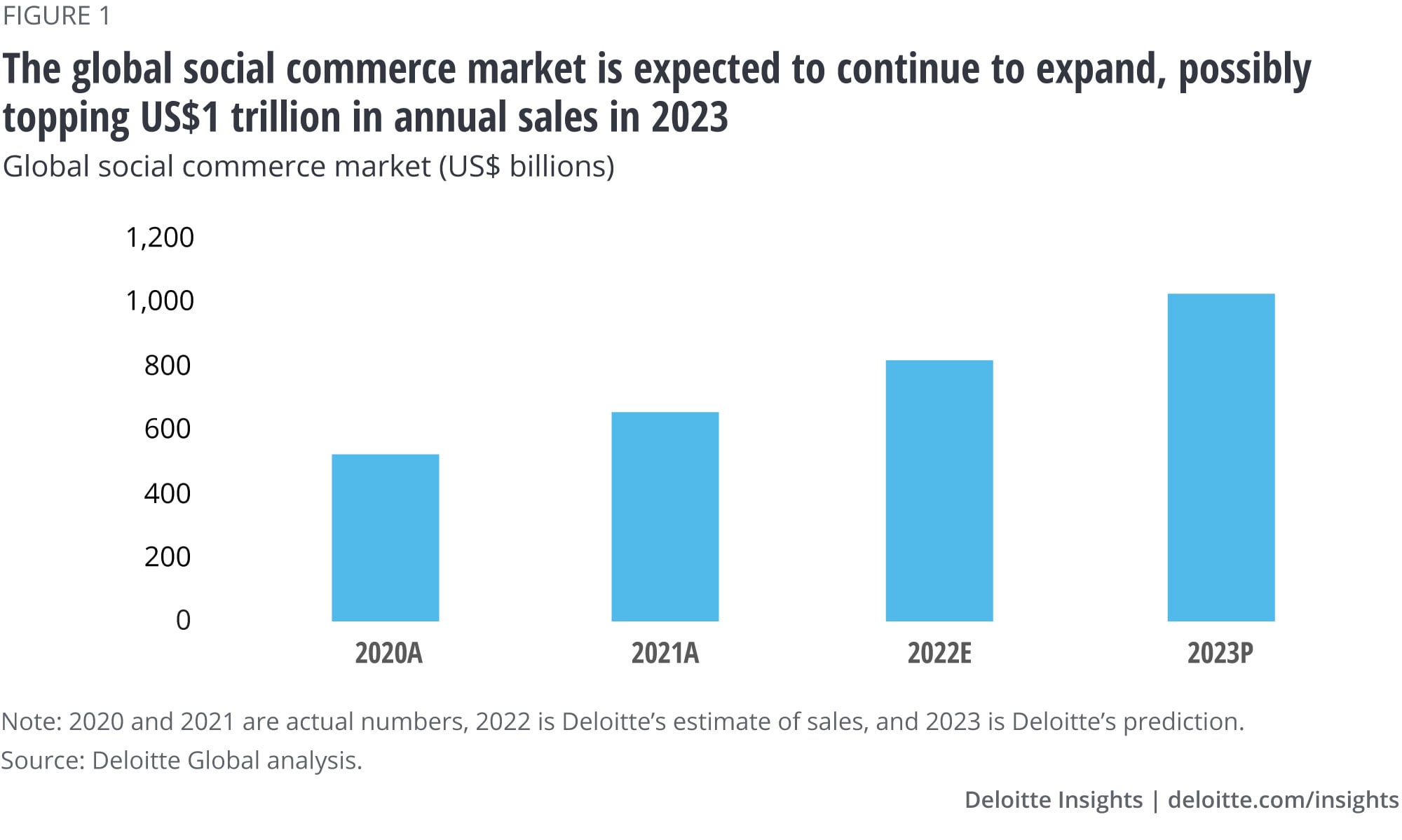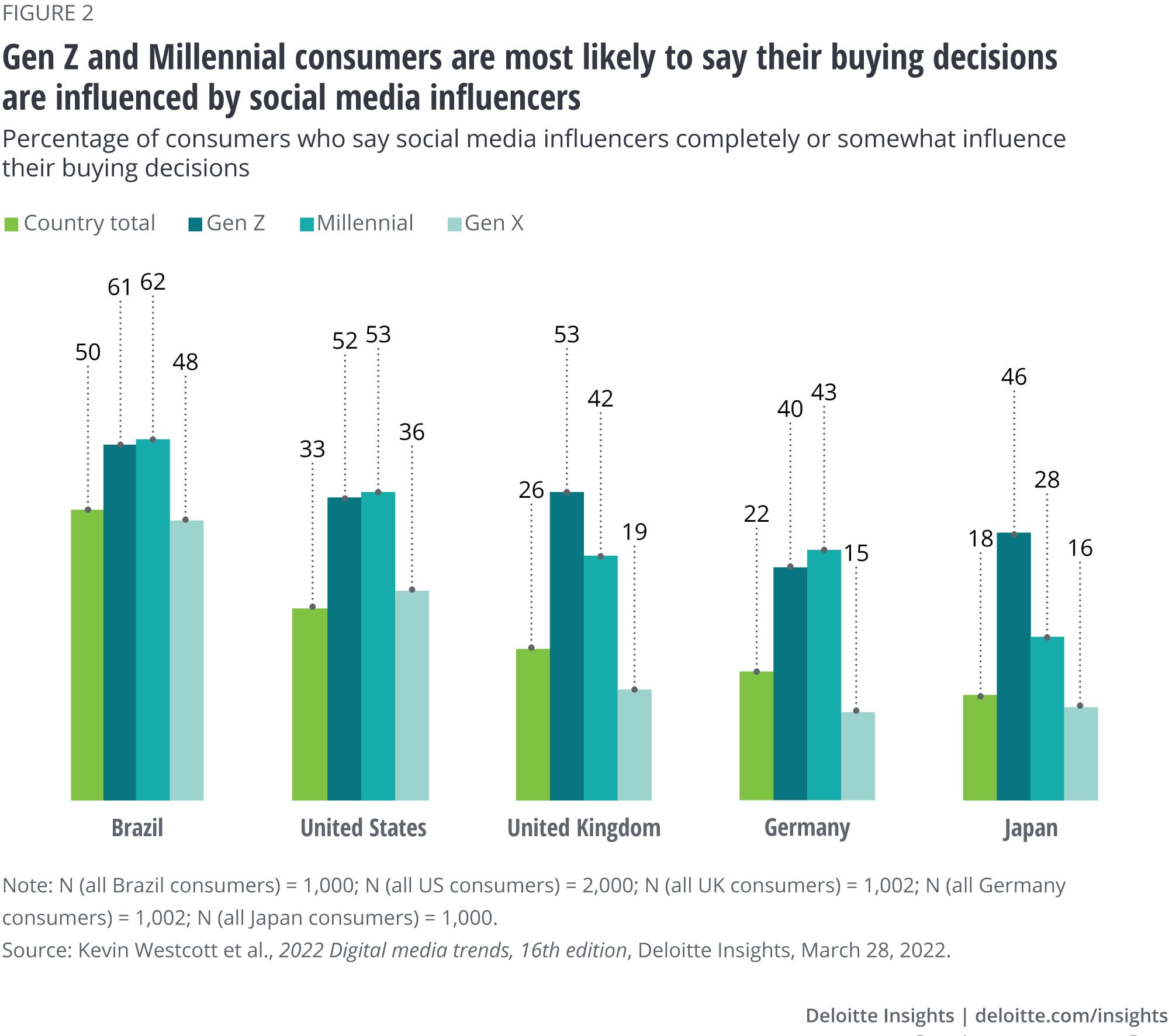As seen in your feed: Shopping goes social, trending past US$1 trillion in annual sales
Propelled by social media influencers and digital-native consumers, social commerce is laying the groundwork for a broader shoppable media landscape.
Brooke Auxier
Kevin Westcott
Ariane Bucaille
Dennis Ortiz
The social media feed is the new storefront—and users are doing more than just window shopping. Deloitte Global predicts that the market for social commerce will surpass US$1 trillion globally in 2023 (figure 1).1 That’s assuming an approximate CAGR of 25%—not unreasonable considering past growth trends and the continued reliance on all things mobile and digital—driven by the purchases of the more than 2 billion people expected to shop on a social media platform in 2023.2

Shopping on social: The ultimate in inspiration and instant gratification
Social commerce—a consumer experience on a social platform that blends the point of inspiration and the point of purchase—marries serendipitous product discovery with effortless digital payment to create shopping opportunities that are hard for many to resist. Imagine seeing your favorite influencer’s latest post in your social feed—and they’re wearing the coolest pair of shoes you’ve ever seen. With a couple of quick taps, you can add those exact shoes to your virtual cart, “buy now” with a mobile payment service, and get them delivered to your doorstep within a few days. All without leaving your couch … or your device.
With an expected 5 billion social media users worldwide in 2023,3 the social commerce market is growing faster than traditional e-commerce,4 and it shows no signs of slowing down. Fueled initially by a surge in popularity during COVID-19,5 the market is continuing to expand despite ebbs and flows in the pandemic. Research from 2021 shows that about a third of US consumers had ever made a purchase directly on social media, and an even larger share said that seeing a product on social media was part of their buying journey.6
So what’s behind all this growth? In large part, it’s the rise of the “creator economy,” the cadre of millions of “influencers” or “creators” who use their clout to promote, advertise, and sell products to their captivated audiences. These online personalities have global reach: In many countries, including the United States, the United Kingdom, Germany, Brazil, and Japan, at least 60% of people say they follow influencers. To convert these loyal fans into repeat customers—which is largely how they monetize their online content7—influencers build relationships with their followers, encourage community among their devotees, and sell their lifestyle with every new snap and selfie. Many make thousands of dollars per post, though compensation varies widely based on the number of followers they have on a given platform.8
Social commerce—a consumer experience on a social platform that blends the point of inspiration and the point of purchase—marries serendipitous product discovery with effortless digital payment to create shopping opportunities that are hard for many to resist.
Social media users have proven a receptive audience for influencers’ sales tactics. One-third of US consumers, for instance, say that social media influencers … well … influence their buying decisions. In Brazil, that figure increases to 50%, perhaps because people in Brazil are more likely to use social media and follow influencers compared to people in the other countries surveyed.9 The influence of social influencers is likely higher still in markets like China, where the social commerce landscape is even more developed and sophisticated.10
At around 20% of the global population, Millennials currently dominate the social commerce market (figure 2).11 But not to be overlooked is the maturation of many Gen Zs to an age where many have more money to spend. Gen Z is the world’s biggest generational cohort, accounting for more than 30% of the population worldwide,12 and most of this burgeoning generation of digital natives tend to be all social, all online, all the time. Nearly all Gen Zs surveyed across the United States, the United Kingdom, Germany, Brazil, and Japan say they use social media platforms, with 85% of responding US Gen Z social media users saying they go on social media daily. Further, more than half of US Gen Zs say they use social media for shopping inspiration,13 which is the first, and arguably the most important, step in the purchasing journey. In the future, Gen Zs are expected to continue to be very much online, where they’ll continue to get hypertargeted and personalized ads for products they want and need—straight from the influencers they already know and love.

The bottom line
The expanding social commerce ecosystem is full of opportunity for brands, social platforms, and developers alike. Brands and influencers should focus their efforts on discovering which product categories are ripe for social commerce as well as tracking cultural shifts in user behaviors and buying preferences.
The creator economy—and the content influencers produce and post—has increased media consumption on social platforms overall, making these platforms ideal channels for brands to capture potential customers where they are already spending their time. Identifying and activating an inclusive cohort of influencers, who not only represent the brand but can relate to and connect with ideal customers, could thus be central to cracking the social commerce code.14
In addition, brands can benefit by utilizing social advertising’s hypertargeted and personalized features. Social media algorithms that determine which ads are displayed in a user’s feed can be highly effective, drawing on billions of data points and powerful analytics to understand consumers and their needs. More than four in 10 consumers surveyed across the United States, the United Kingdom, Germany, Brazil, and Japan say they see ads on social media for things they have been looking for.15 Launching novel social shopping experiences, such as livestreamed events (already highly successful in China)16 or augmented reality–powered try-ons, could also be key.
Most social platforms are already benefiting from influencers’ success in reaching and selling to their audiences: the platform gains new avenues for monetization, and it retains users who are captivated by influencer content. These platforms, as well as technology developers, can seek to further cash in by building infrastructures and capabilities that support fully integrated, intuitive shopping and payment experiences—not just on social media, but on streaming video platforms, gaming services, music and podcast services, and just about everywhere else in the future metaverse.
As social commerce evolves globally through continued experimentation and by looking to more mature markets for guidance, it has the opportunity to draft the blueprint for the broader shoppable media landscape, making new products easier to find, simpler to pay for, and quicker to buy across digital experiences. Looking beyond 2023, most digital experiences are expected to be considered “shoppable,” and the same tap-to-purchase behavior available on social media platforms will likely be possible with other online services, too. Imagine watching a cooking show on a streaming video service. Just pause, select the recipe, add the items to your virtual grocery cart, select a delivery time, use mobile payment, wait for the doorbell to ring—and voila! Dinner is served.